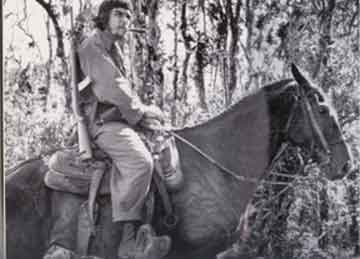 People's Democracy
People's Democracy
(Weekly
Organ of the Communist Party of India (Marxist)
No. 42
October 15, 2006
(Weekly
Organ of the Communist Party of India (Marxist)
|
Vol.
XXX
No. 42 October 15, 2006 |
IMMORTAL CHE

He made himself velocity, sudden light.
He studied to be a hurricane wind.
He fought himself until his blood was extinguished,
Only then was he worthy of his people.
- Pablo Neruda.
“I don’t think you and I are very closely related, but if you are capable of trembling with indignation each time an injustice is committed in the world, we are comrades, and that is more important.” – Che Guevara.
October 9, 2006 marks the beginning of the fortieth anniversary of the martyrdom of Che Guevara. Che and his band of guerrillas were captured and assassinated in Bolivia on the orders of the Central Intelligence Agency (CIA) on Oct 9, 1967. The CIA and its collaborators went to great lengths to give misleading information about the circumstances surrounding his death and the site where he was buried. It was the joint efforts of a team of Argentinian, Cuban and Italian forensic experts anthropologists and geo-physicists that finally located the grave the mortal remains of Commandant Che Guevara and four of his comrades were returned to Cuba in July, 1997. .
The doctor turned revolutionary was born in Buenos Aires, Argentina, in 1928, the son of an architect. Shortly after receiving his medical degree, he enlisted in the cause of the oppressed of Latin America. He fought in Guatemala, was one of architects of the victorious revolution in Cuba and died in Bolivia fighting for the cause of justice and socialism. He was 39 then.
Living in Guatemala during 1954, he became involved in political activity there and was an eyewitness to the overthrowing of the elected government in a CIA organised military operation.
In July 1955 he met Fidel Castro and On November 25, 1956 he was part of the expedition that sailed to Cuba aboard the cabin cruiser ‘Granma’ to begin the revolutionary struggle in the Sierra Maetra mountains. Originally the troop doctor, “Che” as the Cubans nicknamed him, became the first rebel Army Commander in July 1957.
At the end of December 1958, Guevara led the rebel army forces to victory in the battle of Santa Clara, one of the decisive engagements of the war.
In April 1965 Guevara left Cuba to participate directly in revolutionary struggles abroad.
In November 1966 he arrived in Bolivia where he led a guerrilla detachment fighting that country’s military dictatorship. Wounded and captured by U.S. trained and supervised Bolivian counter insurgency troops on October 8, 1967, he was murdered the following day.
National flags, prejudices, chauvinism, and egoism had disappeared from his mind and heart. And he was ready to shed his generous blood spontaneously and immediately, on behalf of any people, for the cause of any people!
LANDMARKS IN THE LIFE OF ERNESTO CHE GUEVARA

Che in Santa Clara in 1958
1928, June 14-- born in the city of Rosario, the first-born of Ernesto Guevara Lynch and Celia de la Serna.
1946-53 -- student in the medical school at the National University in Buenos Aires.
1951, February to 1952, August - travels about Latin America.
1953-- finishes his studies.
1953-54--Che makes a second journey through Latin America. In Guatemala he participates in the defence of the government of President Arbenz, and after its defeat he settles in Mexico.
1955--Che meets Fidel Castro, joins his revolutionary unit, and takes part in preparations for the Granma expedition.
1956, June-August -- Che is imprisoned in Mexico City as a member of Fidel’s unit. On November 25, he sets out on the Granma. The Granma lands in Cuba on December 2. 1956-1959-- Che participates in the revolutionary war of liberation in Cuba and is twice wounded in combat.
1957, May 27-28 -- the battle of Uvero. On June 5 Che is appointed Major and placed in command of the Fourth Column.
1958--In December the offensive on Santa Clara is launched. Between December 28 and 31. Che leads the battle for Santa Clara.
1959, January 1, the liberation of Santa Clara. On January 2 Che’s column enters Havana. On November 26 he is appointed Director of the National Bank of Cuba. 1960-- Che visits the Soviet Union, Czechoslovakia, the GDR, China and the Korean People’s Democratic Republic at the head of an economic mission.
1961-- On February 23 Che is appointed Minister of Industry and member of the Central Planning Council.
1964-- He heads the Cuban delegation to a UN Conference on Trade and Development in Geneva. Between December 9 and 17 Che heads the Cuban delegation to the UN General Assembly.
1965--He writes farewell letters to his parents, children and to Fidel Castro.
1966-- On November 7 he arrives at the guerrilla base on the Nancahuasu River in Bolivia.
1967-- On March 23 the guerrilla unit called the Army of National Liberation of Bolivia headed by Che begins its military operations. On October 8, Che is wounded and captured in a battle in the Yuro Hollow. On October 9 Che is murdered by rangers in the village of Higuera. On October 15 Fidel Castro confirms Che’s death in Bolivia.